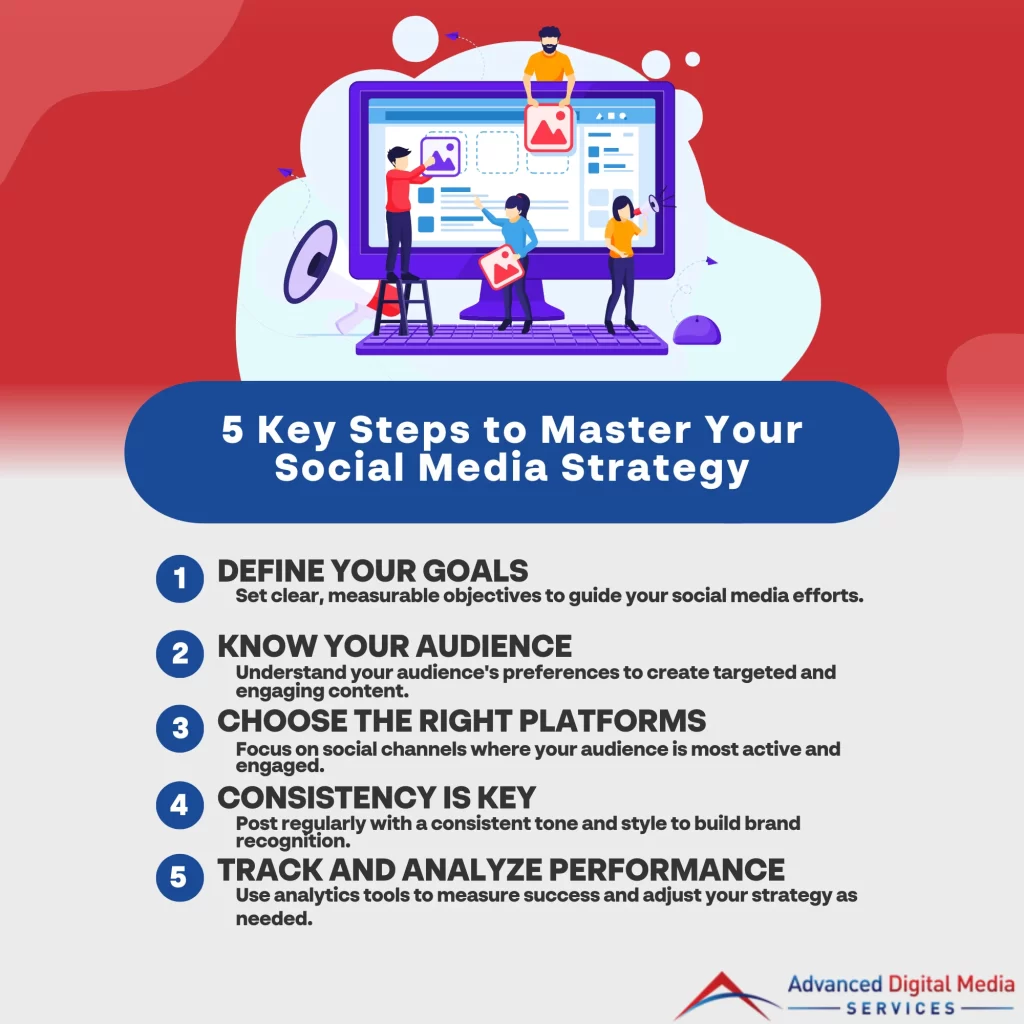Managing your social media effectively is all about strategy and connection. Start by knowing your audience—analyze demographics and engagement metrics to tailor content that resonates. Choose the right platforms where your target group is most active, and create a content calendar for consistent updates. Utilize social media management tools to streamline your efforts and schedule posts ahead of time. Regularly measure your performance to refine your approach and align with your business goals. Stay active and consistent in your voice to foster trust. There’s so much more to this journey, waiting for you to explore.

Key Takeaways
- Understand your audience by analyzing demographics and engagement metrics to tailor content that resonates with their interests.
- Select the right platforms where your target audience is most active to maximize reach and engagement.
- Develop a content calendar to strategically plan posts around key dates and diversify content types for audience engagement.
- Utilize social media management tools to streamline posting, scheduling, and performance tracking across multiple platforms.
- Regularly measure performance through key indicators and adjust strategies based on data-driven insights to align with business goals.
Know your audience
In today’s fast-paced digital landscape, knowing your audience is essential for effective social media management. To manage social media accounts successfully, you need to understand who your followers are, what they value, and how they engage with content.
Start by analyzing demographics, interests, and behaviors. This data will guide your content strategy, ensuring it resonates with your target audience.
Next, consider using tools like surveys or polls to gather direct feedback. This approach not only fosters engagement but also provides valuable insights into your audience’s preferences. When you know what they like, you can tailor your posts to create more meaningful interactions.
Another critical aspect of how to manage social media is monitoring engagement metrics, such as likes, shares, and comments. These indicators reveal what types of content perform best, helping you refine your strategy over time.
Choose your platforms
Selecting the right social media platforms is essential for reaching your target audience effectively. Not all platforms will resonate with your audience, so you need to analyze where they spend their time. For example, if your target demographic skews younger, platforms like TikTok and Instagram may be your best bets. Conversely, if you’re aiming for professionals, LinkedIn could be the key player.
Once you’ve identified the platforms that align with your goals, consider how to manage multiple social media accounts efficiently. Using tools that let you manage social media accounts in one place can save you time and help streamline your content strategy. This way, you can schedule posts, track engagement, and analyze performance across multiple platforms without the hassle of logging in and out.
Don’t forget to keep your brand voice consistent across all platforms while tailoring your content to fit each one’s unique characteristics.
Create a content calendar
Managing your social media presence effectively means not just choosing the right platforms but also planning your content strategically. One of the best ways to achieve this is by creating a content calendar. This tool helps you manage social media marketing by outlining what, when, and where you’ll post your content.
Start by identifying key dates, events, or themes relevant to your audience. This guarantees your posts are timely and engaging. Break down your content types, such as promotional posts, educational articles, or user-generated content, to keep your feed diverse and interesting.
Next, determine a posting frequency that works for you—whether that’s daily, weekly, or bi-weekly. Consistency is key to maintaining audience engagement.
Use your calendar to visualize your strategy, allowing you to see gaps that need filling or opportunities for cross-promotion between platforms.
Use social media management tools
Utilizing social media management tools can considerably enhance your marketing efforts, streamlining the way you create, schedule, and analyze your posts.
With the right tools, you’ll effortlessly manage all your social media platforms from one central location, saving you time and energy.
Here are three key benefits of using these tools:
- Scheduling Flexibility: You can plan and schedule posts in advance, ensuring consistent content delivery even during your busy days.
- Analytics Tracking: Most tools provide in-depth analytics, allowing you to measure engagement and optimize your strategies based on real-time data.
- Content Curation: These tools often offer features to help you discover and share relevant content, keeping your audience engaged and informed.
Create a content strategy
A well-crafted content strategy is essential for any successful digital marketing campaign. To effectively manage social media platforms, you need to define your goals, audience, and messaging.
Start by identifying what you want to achieve—whether it’s brand awareness, lead generation, or customer engagement.
Next, know your audience inside and out. Research their preferences and behaviors to tailor your content. This guarantees your messaging resonates and drives engagement.
Once you have this foundation, develop a content calendar that outlines what, when, and where you’ll post. Consistency is key in how to manage social media marketing effectively.
Diversify your content types, using a mix of videos, images, and articles to keep your feed fresh and engaging.
Don’t forget about leveraging user-generated content to build community and trust.
Measure your performance
Measuring your performance is essential to understanding the effectiveness of your social media strategy. Without proper assessment, you can’t identify what’s working and what needs improvement.
To efficiently manage business social media, consider these key performance indicators:
- Engagement Rate: Track likes, shares, and comments to gauge how well your content resonates with your audience.
- Follower Growth: Monitor the increase in your follower count to understand your reach and appeal over time.
- Conversion Rate: Analyze how many social media interactions lead to desired actions, such as purchases or sign-ups.
Utilizing a robust manage social media tool can simplify this process. These tools allow you to gather data efficiently and generate insightful reports.
Regularly reviewing your metrics helps you refine your strategy, ensuring that your efforts align with your business goals.
Ultimately, a data-driven approach empowers you to adapt, optimize, and enhance your social media presence.
Be active
Tracking your performance provides valuable insights, but to truly make an impact, you need to be active on your social media platforms. Engaging consistently with your audience is essential. Make it a habit to post regularly, respond promptly to comments, and share relevant content. This level of activity not only keeps your followers interested but also helps you build a loyal community.
When you manage multiple social media accounts, it’s important to tailor your approach for each platform. Understand the nuances of how to manage social media accounts effectively. For instance, while Instagram thrives on visuals, Twitter values concise, timely updates.
Utilize scheduling tools to streamline your efforts across platforms, ensuring you’re present even during your busiest times.
Don’t underestimate the power of interaction—like, share, and comment on posts from others in your industry. This not only expands your reach but also positions you as an active participant in your niche.
Maintain a consistent voice
To truly resonate with your audience, maintaining a consistent voice across all your social media platforms is crucial. A cohesive voice not only strengthens your brand identity but also builds trust and engagement with your followers.
Here’s how to achieve that:
- Define Your Brand’s Personality: Identify the tone and style that best represent your brand. Are you casual and fun, or professional and authoritative?
- Create a Style Guide**: Document your voice, preferred language, and visual elements. This guide will help you and your team stay aligned as you manage all your social media in one place.
- Monitor and Adjust: Regularly review your posts to confirm they reflect your defined voice. Don’t hesitate to adjust based on audience feedback and engagement metrics.
Frequently Asked Questions
How Do I Handle Negative Comments on Social Media?
To handle negative comments, acknowledge them promptly and empathetically. Address concerns directly, offer solutions, and keep the conversation public to showcase transparency. Remember, it’s an opportunity to demonstrate your commitment to customer satisfaction.
What Is the Best Time to Post on Social Media?
To maximize engagement, post during peak hours when your audience is most active. This typically includes weekdays around lunch and evenings. Experiment with different times to find what works best for your specific audience.
How Can I Boost Engagement With My Followers?
To boost engagement with your followers, consistently share valuable content, ask questions, and respond promptly. Utilize eye-catching visuals and analyze your audience’s preferences to tailor your posts, ensuring they resonate and encourage interaction.
Should I Pay for Social Media Ads?
Think of social media ads like planting seeds in a garden; they can yield great returns. If you target wisely and analyze results, you’ll likely see growth in engagement and reach. Don’t hesitate to invest!
How Often Should I Review My Social Media Strategy?
You should review your social media strategy quarterly. This allows you to analyze performance, adapt to trends, and guarantee your content aligns with your goals. Regular adjustments keep your approach fresh and effective for audience engagement.
Conclusion
So, you thought managing social media was just about posting pretty pictures, huh? In reality, it’s a strategic chess game where knowing your audience and analyzing data can make or break your brand. By embracing the tools and techniques outlined in this guide, you’ll turn your social media from a casual pastime into a powerful asset. Get ready to watch your online presence flourish as you connect authentically and strategically with your audience. Who knew it could be this impactful?






